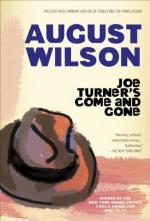|
This section contains 269 words (approx. 1 page at 400 words per page) |

|
Joe Turner's Come and Gone Summary & Study Guide Description
Joe Turner's Come and Gone Summary & Study Guide includes comprehensive information and analysis to help you understand the book. This study guide contains the following sections:
This detailed literature summary also contains Bibliography and a Free Quiz on Joe Turner's Come and Gone by August Wilson.
August Wilson's Joe Turner's Come and Gone, first produced in 1986 by the Yale Repertory Theatre, was published in the United States in 1988. The play was inspired both by the 1978 Romare Bearden artwork, Mill Hand's Lunch Bucket, and the blues song, "Joe Turner's Come and Gone." The song, which was recorded by legendary blues artist, W. C. Handy, was first sung by many estranged black women who had lost their husbands, fathers, and sons to Joe Turner—a plantation owner who illegally enslaved blacks in the early twentieth century. Joe Turner's Come and Gone is the third play in Wilson's ten-play historical cycle, in which the playwright is chronicling the African-American experience in the twentieth century by devoting a play to each decade. Joe Turner's Come and Gone represents the 1910s.
Set in a Pittsburgh boardinghouse in 1911, the play examines African Americans' search for their cultural identity, following the repression of American slavery. For Herald Loomis, this search involves the physical migration from the South to Pittsburgh in an attempt to find his wife. Pittsburgh was one of the many urban areas in the North that other blacks migrated to in the 1910s, in an effort to flee the discrimination they faced in the South, while attempting to find financial success in the North. Herald's search for his identity, represented as his song, is unsuccessful until he has embraced the pain of both his own past and the past of his ancestors, and moved on to self-sufficiency. A copy of the play can be found in August Wilson: Three Plays, published by University of Pittsburgh Press in 1994.
Read more from the Study Guide
|
This section contains 269 words (approx. 1 page at 400 words per page) |

|



